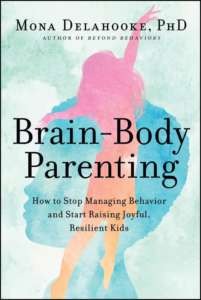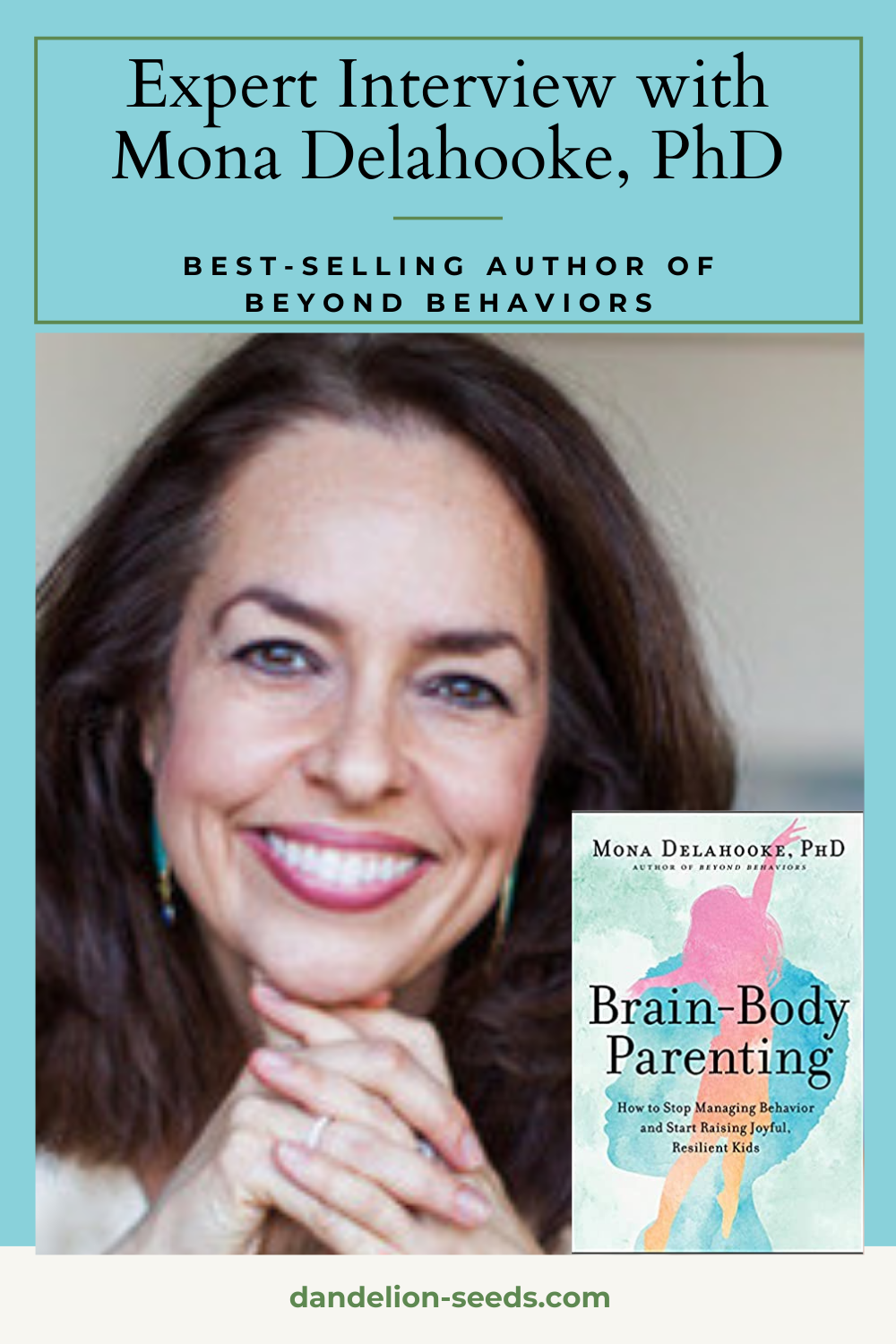
Sign in
Don't have an account with us? Sign up using the form below and get some free bonuses!

In a recent interview with Dandelion Seeds Positive Parenting, leading child psychologist Mona Delahooke, PhD, discussed her new book, Brain-Body Parenting: How to Stop Managing Behavior and Start Raising Joyful, Resilient Kids, available here (afflinks).

Many parents know Dr. Delahooke from her best-selling book Beyond Behaviors (available here, along with the Beyond Behaviors Flip Chart, here). Her brilliant work in child psychology helps parents shift their perspectives about challenging behaviors and gain a deeper understanding of how to support children through connection.
Supporting children from the inside out, she clearly explains the biology beneath behavior. Moreover, rather than suggesting a one-size-fits-all approach to common challenges, Dr. Delahooke describes the essential role of parenting to individual differences.
In Brain-Body Parenting, Dr. Delahooke offers insight that helps parents tend to their children's entire nervous system, thereby supporting connection and encouraging children's increased resilience. With her experience as a clinical psychologist, she offers readers a helpful understanding of neuroscience and polyvagal theory. Fortunately for those of us who aren't scientists, she writes in everyday terms that are easy to understand and that promote more harmonious family dynamics.

She's a proponent of co-regulation, which involves supporting our children's emotional needs alongside them, encouraging calmer behavior by being calm and peaceful, ourselves. This ultimately helps grow their self-regulation skills -- with better behavior as a fortuitous byproduct.
Having drawn from her clinical experience as well as the most recent research in child development, this new book by Dr. Delahooke is a must-have for parents and caregivers.
Below is an excerpt from an interview with Mona Delahooke, Phd, expert in clinical psychology and child development. If you'd like to watch the full video about how to have a more connected relationship and a deeper understanding of brain science, it's available for free here.
As I was reading your book and thinking about the families I support, your subtitle jumped out at me: "How to Stop Managing Behavior and Start Raising Joyful, Resilient Kids." Many parents are going to say, "Hold the phone, Mona. What do you mean, stop managing behaviors? Behavior is what I see!" Can you talk a little bit about what that means? I'd also love hear about the concept of top-down and bottom-up behavior.
That's such a great question because, yes, what else do we have other than behaviors to go by? Many of us, including myself, were either taught or grew up in a culture of thinking that managing behaviors is end product. That is what we do, right? We deal with children's behavior so that we increase the behaviors we want to see; the "good" behaviors -- and we do something to lessen the "bad" behaviors.
That's how we think about behaviors, but when I became a infant and toddler specialist, I was able to learn this whole notion that behaviors are really just a signal of what's going on on a much deeper level.
Behaviors are like the tip of the iceberg. What's going on underneath the waterline, which is invisible, is all those things that we aren't really taught about that create the behaviors, right? They create the sensations, the feelings, the, the thoughts, and eventually the emotions that humans feel. - Dr. Mona Delahooke
Then there's this whole notion that there's a difference between top-down and bottom- or body-up behaviors. That was news to me when I learned it in my training. I'll never forget one of my instructors saying, "So is this a top-down or bottom-up behavior?" I was thinking, "Well, I don't know. What's the difference?"
Now I know the difference. Our bottom- or body-up behaviors are prevalent in all humans. They happen when our nervous system shifts into a pathway that is created in our biology to help protect our bodies and help us to feel safer. A body behavior is something that is not conscious. It's subconscious.
We're not aware of it happening, but we're aware of the consequences of it: a more rapid heart rate, sweaty palms, sweaty nose, a red face; or our child hitting, kicking, screaming, punching, spitting.
Those are indicators of a bottom- or body-up response. It really is a biological phenomenon.
When we think about managing behaviors, I'm trying to help us really see that what we're managing is a nervous system. - Dr. Mona Delahooke
And when our children's nervous systems are on what I call a vulnerable platform, that's when you see those behaviors that we all kind of dread as parents. Now, we can see them in a new light as indicators of a vulnerable or shaky platform. When we do, then a whole new array of what to do falls from that.
Yeah, that really is a paradigm shift. So many of us are used to "Well, if I see this behavior, I do that to make it stop," without exploring what's really going on.
You mentioned pathways. Can you talk a little bit about your pathways concept?
Right. The pathways concept is really just another way of thinking about something we all have, which is the autonomic nervous system.
One of the theories of the autonomic nervous system that I think is so useful in helping us translate it from the science to a parenting is the polyvagal theory, also known as the neuroscience of love and engagement. Basically our autonomic nervous system has these different pathways.
To oversimplify things, [I talk about pathways] in terms of colors because it's easier than the scientific names.
The green pathway would be when we're calm; when our bodies are sensing safety. We're feeling good inside and outside our bodies. The world coming into us is manageable. In children, we see them playing, they're able to learn, and they tend to be more cooperative.
These children are talking to us. Their body language is one of calmness: their voices, their posture, the way they're holding their bodies. You see calmer behavior and an engaged, happy child. That's a wonderful place to be.
But as human beings, we can't [always] live [in the green pathway] because we're not robots and our our world presents challenges.
No matter if you're a three-year-old where, you know, the challenge might be that you got the wrong kind of food for lunch, or as an adult, it might be that you get really bad news.
In these situations, we have these protective other pathways. The first one that we generally go to involves movement and it's called the red pathway. That's where we might have increased heart rate, sweaty palms -- like I said, your nervous system is detecting threat.
You might see challenging behaviors like kicking, hitting, screaming, or running away. Those kinds of behaviors that we may tend to think about as misbehavior or challenged behaviors can be a sign of this autonomic distress, in which their nervous system is trying to feel better through movement. One to think about this behavior is, "Oh no, I have to shift this behavior. My child's nervous system is feeling vulnerable right now. This is a vulnerable platform, not a misbehaving child. - Dr. Mona Delahooke
And then there's also a third pathway. We know now that there are blended pathways, as well. But just for our purposes, the blue pathway may be where a child is just kind of blue and shut down, not wanting to move much. They're not wanting to to play or to seek contact. They might have very sad look on their face and a very quiet voice.
We move through these pathways adaptively throughout the day.
So you may have moments of feeling blue and hopeless, but we want to watch out for blue or red pathways predominating over days and weeks...We want to see a child spending about seventy percent of their waking hours in the green.
The full interview is available here.

Mona Delahooke, PhD, is a licensed clinical psychologist with more than 30 years of experience caring for children and their families. She is a senior faculty member ofthe Profectum Foundation, an organization dedicated to supporting families of neurodiverse children, adolescents and adults. She is a trainer for the Los Angeles County Department of Mental Health.
Dr. Delahooke holds the highest level of endorsement in the field of infant and toddler mental health in California, as a Reflective Practice Mentor (RPM). She is a frequent speaker, trainer, and consultant to parents, organizations, schools, and public agencies. Dr. Delahooke has dedicated her career to promoting compassionate, relationship-based neurodevelopmental interventions for children with developmental, behavioral, emotional, and learning differences.
She is the author of the award winning book Beyond Behaviors: Using Brain Science and Compassion to Understand and Solve Children’s Behavioral Challenges (PESI, 2019), and Social and Emotional Development in Early Intervention: A Skills Guide for Working with Children (PESI, 2017). Her popular blog, at www.monadelahooke.com covers a range of topics useful for caregivers and childhood providers. Follow her on Facebook: @DrMonaDelahooke, Instagram: @monadelahooke and Twitter @monadelahooke.
Sarah R. Moore is the founder of Dandelion Seeds Positive Parenting, an author (first parenting book coming 2022), an armchair neuroscientist, and most importantly, a Mama. She's a lifelong learner with training in child development, improv comedy, trauma recovery, and interpersonal neurobiology. She helps bring JOY, EASE, and CONNECTION back to families. Take her science-based and video mini-courses here, and follow her on Facebook, Instagram,
